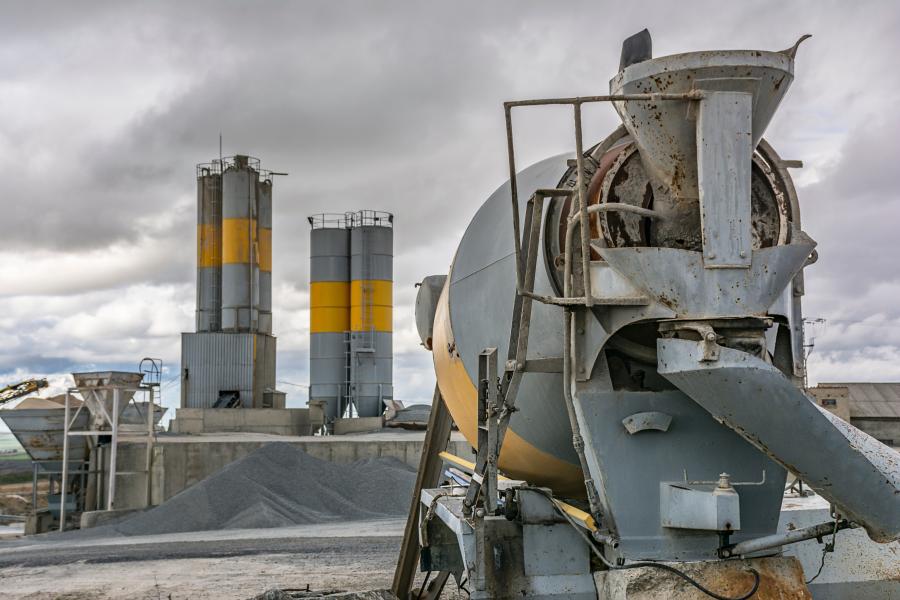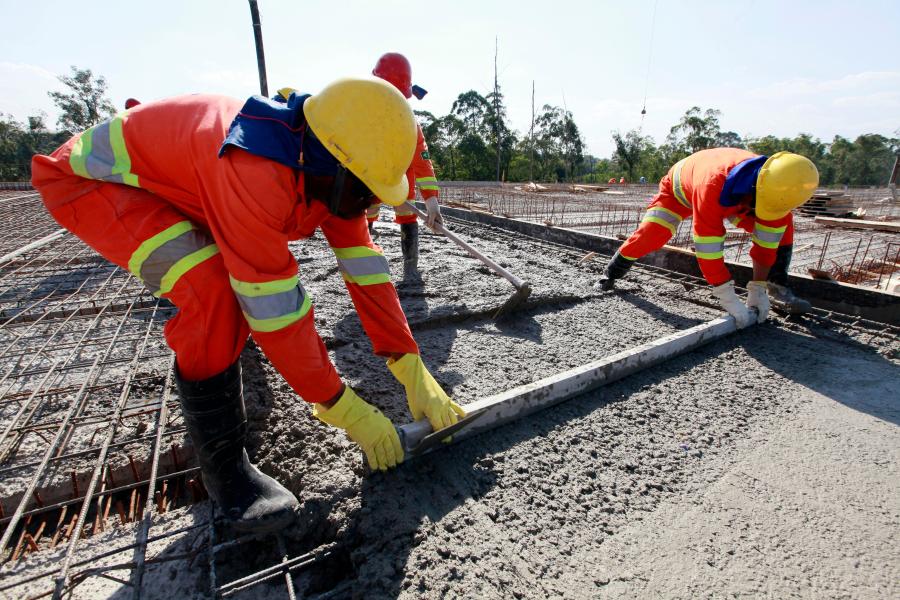Cement manufacturers can reduce the carbon in the clinker-making process, of which limestone is the primary raw material.
Marking a year of progress toward its goal of carbon neutrality, the Portland Cement Association (PCA) last fall noted the multiple pilot projects across the United States that have showcased emerging technologies to capture and reuse or store carbon. Those projects are tools to gauge success as the industry moves toward eliminating all carbon in concrete by the year 2050.
"I'm proud that our industry is taking this on," said Mike Ireland, president and CEO of PCA. "Together we've made progress on a bold, yet achievable pathway to carbon neutrality."
Ireland noted the industry is "creating a win-win scenario to meet demand for durable infrastructure that also has a low carbon footprint, which will result in a more sustainable and resilient world for the next generation."
The industry's "unified approach" to decarbonization is the central focus of the PCA's Roadmap to Carbon Neutrality.
With the demand for infrastructure never greater, it's vital for the built environment to advance in a fashion that is sustainable and climate adapted, said the PCA.
"This need spotlights the importance of the progress PCA — representing America's cement manufacturers — has made on its efforts to reduce emissions."
In the first year, the campaign saw multiple U.S. cement manufacturers working with the Department of Energy to implement pilot programs around the concept of carbon capture, utilization and storage (CCUS).
The association reported increased acceptance and use of Portland limestone cement (PLC), a product that reduces concrete's carbon footprint by approximately 10 percent.
"In addition to private building projects, PLC has been approved by 44 state departments of transportation, some of the largest consumers of cement," noted PCA.
Consumer demand for sustainable concrete is growing, and companies are specifying low-carbon materials for major construction projects.
"Through this Roadmap, we are creating a built environment that is durable and also sustainable," said Ron Henley, president, GCC of America, and PCA board member. "We are demonstrating that the cement and concrete industry can address climate change, reduce greenhouse gases and eliminate barriers restricting environmental progress."
In fact, the industry is pushing innovation and calling on stakeholders for more collaboration, according to PCA. The association is working with Congress and federal agencies to maximize the benefits of both the IIJA and the IRA.
Both policies, it noted, provide significant funding for the clean technologies the cement industry requires to reduce emissions.
PCA also wants to see existing legislation, such as the Resource Conservation and Recovery Act, modernized to accelerate cement and concrete's path to carbon neutrality. This would also ensure concrete made with cement remains the sustainable building material of choice, the association maintains.
PCA said its comprehensive approach will allow for the industry to continue aligning with private partners, government, industry and technology leaders on solutions, regulations and policy changes. This effort would result in empowering the industry and others to realize this shared societal mission, according to the organization.
Daunting Journey
"What gives us hope is the fact that there is a big rise in ambition across the industry," said Radhika Lalit of sustainability consulting firm Rocky Mountain Institute (RMI).
"Companies, corporations, real estate players, anybody who's constructing new buildings, new ports, new highways, new roads, is looking into these materials."
She said a coalition of more than 65 corporate buyers, known as the First Movers Coalition, is leveraging the purchasing power of the customers in industries such as cement and concrete.
But to meet the targets of net-zero by 2050, the industry will require some carbon capture in the process, she cautioned.
"It is impossible to fully eliminate process emissions in the cement-making process, and carbon capture will have to remove the remaining CO2," said Lalit. "We estimate that we need around 20 to 30 carbon capture and storage [CCS] plants in operation by 2030. And we have zero plants with CCS at commercial scale right now."
Pilot projects are up and running, she said, but the industry currently lacks a plan that uses CCS technology in full-scale operation. "And we are going to need to get to at least 20 within the decade."
She said many large cement producers are beginning to make investments into CCS and other innovative technologies to reduce their emissions. She is encouraged but is concerned about the lack the speed and scale to fast-track the transition.
"So, I think I'd say we're cautiously optimistic because we see great momentum, but it is a daunting journey."
She believes the industry can see the biggest impact in reducing emissions by focusing on the three Cs: clinker, cement and concrete.
Manufacturers can start by reducing the carbon in the clinker-making process. Limestone is the primary raw material, she said.
"You could use other materials such as calcium silicate, magnesium silicate, steel slag, recycled clinker, mining tailings, crushed concrete waste, as well."
With machine learning and design software, contractors could utilize less concrete in the laying phase, she believes.
Lalit noted that mineralization startups currently store the CO2 in concrete aggregates.
"Supplementary cementitious materials, such as fly ash, slag, volcanic ash and calcined clays have little or no associated emissions and can be introduced into the cement blend to replace a portion of clinker," she said.
Limestone calcined clay cement — calcined clays, limestone, gypsum and clinker — and other innovative cement blends, can "immediately" help reduce carbon emissions by up to 40 percent, she believes.
It would be a cost-effective move that would cause no major changes to the traditional cement plant, she added.
"These innovations are at different technology readiness levels," Lalit cautioned.
Some of them are in concept states, some of them are in large prototype demonstration stages.
"But the key to solving the decarbonization challenge for the industry is seeing some of these innovations achieve commercial success at industrial scale within the next three to five years so that their costs can go down," Lalit added.
Incentives to Reduce
In January, the New Jersey Low Embodied Carbon Concrete Leadership Act (LECCLA) was signed into law to offer a performance-based tax credit to certain concrete producers.
Chris Neidl, policy consultant of the National Resources Defense Council (NRDC), said the new policy is a state-led approach to eliminating embodied carbon emissions.
This is the first program of its kind in the United States and had overwhelming bi-partisan support, said Neidl.
"Public procurement is the focal point of the policy," he said, adding that the aim is mobilizing the influence of state agencies as the single largest purchasers of concrete in New Jersey.
It also focuses on the state's position as lead regulator of specifications, standards and codes related to the material and its use.
"But LECCLA will leverage market dynamics to realize both short- and long-term carbon emissions reductions in this essential industry," said Neidl. "Beginning in 2024, concrete producers who supply at least 50 yards for state-funded construction projects will be eligible for a performance-based tax credit."
That credit applies if the concrete also delivers quantifiable reductions in embodied carbon, said Neidl.
The total amount of tax credits that can be issued each year is $10 million, to be issued on a first-come-first-served basis. And no single concrete producer can claim more than $1 million in credits per year.
Not only does LECCLA introduce an incentive for concrete producers to overperform, but it can build upon other policy advancements, said Neidl.
For example, low carbon concrete specifications and performance-based specifications have gained hold in New York State.
In South Jordan, Utah, Eco Materials is manufacturing cement using coal waste. The result is a product that lowers carbon emissions by 99 percent.
Several exhibitors at World of Concrete showcased their environmentally sustainable products and processes.
"The gauntlet has been thrown down to be more sustainable and reduce carbon," said Grant Quasha, Eco Materials CEO, talking to the Las Vegas Review-Journal. "This industry really has to use technology and innovation to meet future challenges and see advancement."
Improving emissions from making cement will be key to achieving future emission goals.
That's because cement is the most used material in the world behind water, said Eric Ferrebee, senior director of technical services of the American Concrete and Pavement Association (ACPA).
California startup Brimstone has discovered the world's first carbon-negative cement, made from calcium silicate rocks.
"We're just making the same thing from a different rock," Cody Finke, CEO of the Oakland, Calif.-based company, told CBS News.
He said calcium silicate rocks are approximately 200 times more abundant than the limestone traditionally used to make cement.
Calcium in limestone serves as the binding agent in cement. It also contains the greenhouse gas carbon dioxide.
The industry is working to make concrete cleaner, said Steve Regis, cement operations for the CalPortland Oro Grande Cement Plant in southern California.
Brimstone is trying to quickly scale up its cement-making process. The company believes it will be just as reliable as traditional cement, only cheaper.
"We're quite confident that the chemistry works and we can make the same material," Finke said. CEG
Today's top stories























